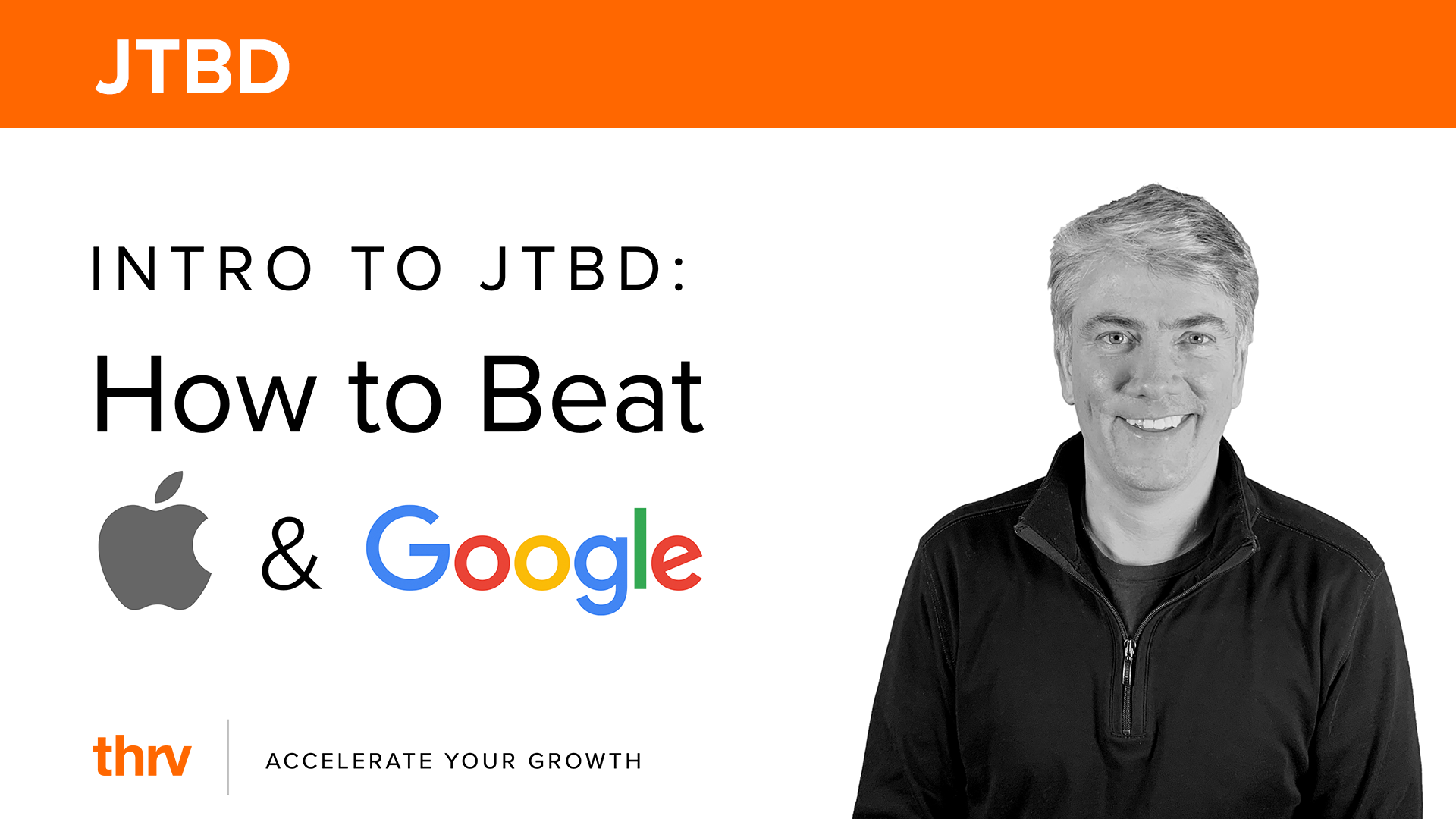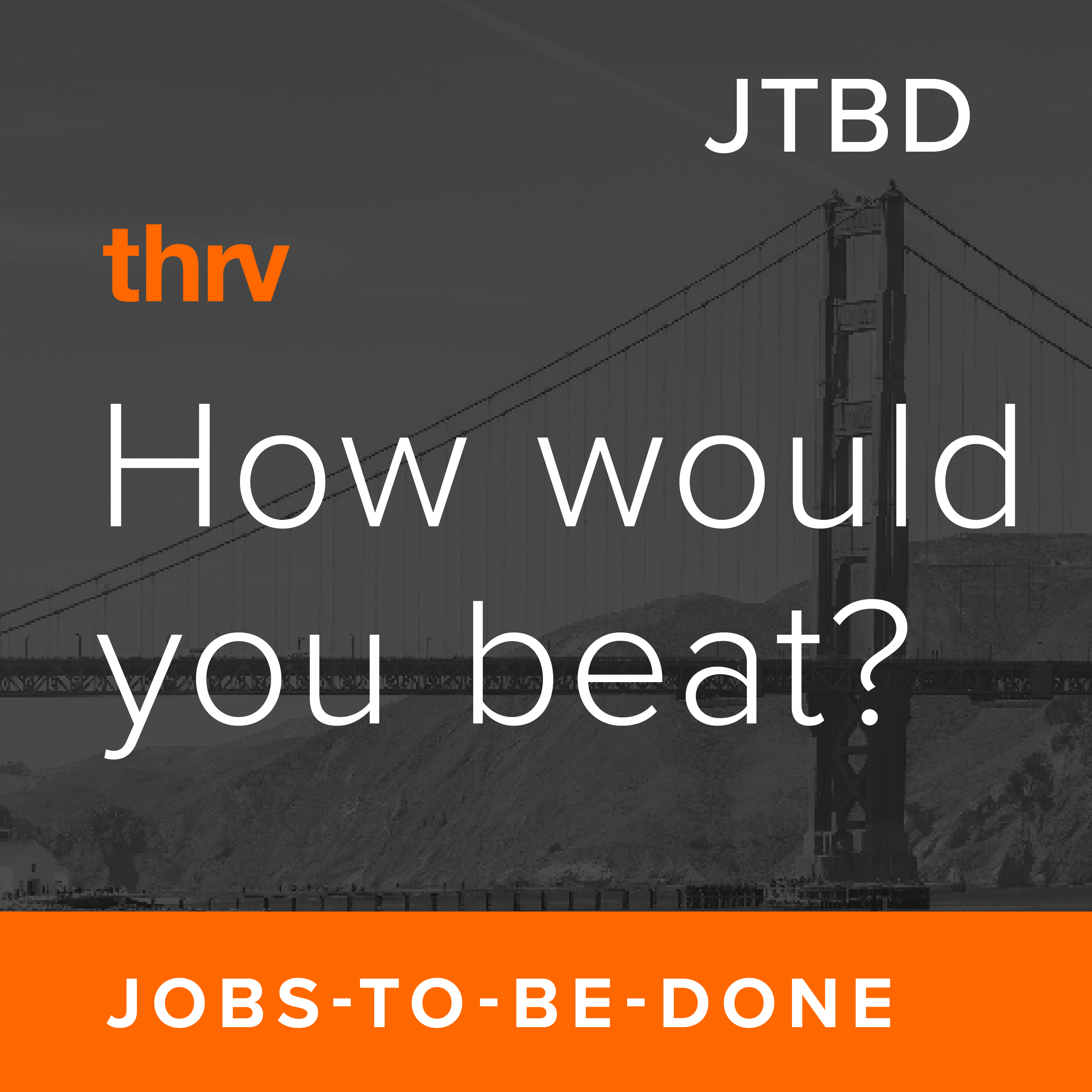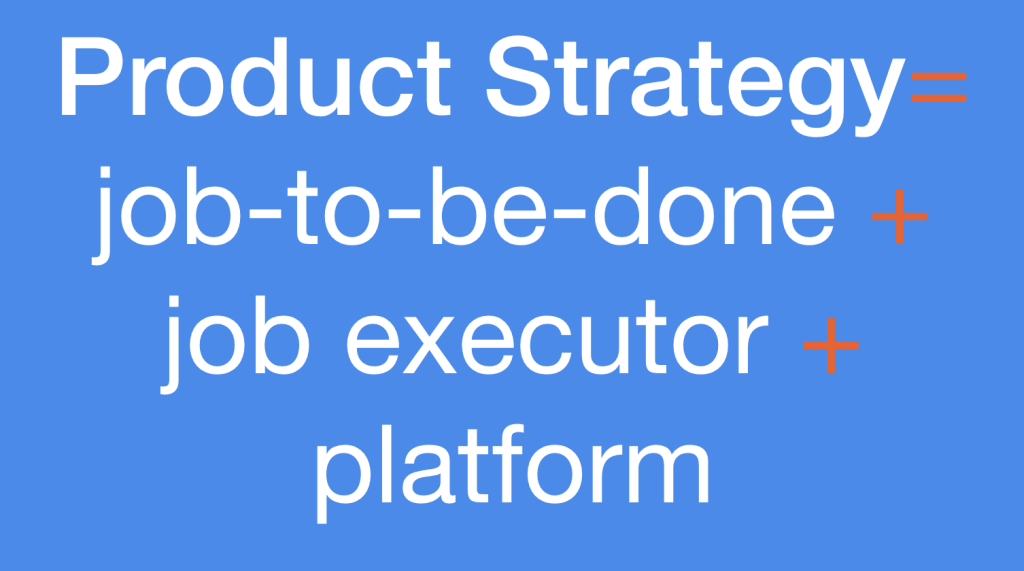
Horace Dediu argues that in the mobile phone market, profit share is the key to creating shareholder value, not market share. This makes sense. You don't want to just sell more product than your competitors (market share); you want to make more money doing it (profit share). For example, Apple sells fewer smartphones and has less market share than Samsung but Apple makes 90% of the profits in the market. It's no surprise that Apple has the largest market cap in the world.
Samsung and Apple have similar products and operational models, but a huge disparity in profit. The Jobs-to-be-Done definition of product strategy highlights the differences between Apple and Samsung's smartphone businesses and provides a rubric for choosing strategies that lead to gaining higher profit share than your competitors.
Here's a traditional definition of strategy: "the set of coordinated actions that a company takes to achieve its goals." Shobhit Chugh's blog post and slideshare apply this definition to product management. This notion of strategy is closely related to Harvard Business School professor Michael Porter's definition from his 1996 article What is Strategy: strategic success is based on "choosing a unique and valuable position rooted in systems of activities that are much more difficult to match." (If you don't subscribe to Harvard Business Review, contact us and we can get you a complimentary copy of the article.)
The focus in both of these definitions is activities. However, it's very difficult to create a "unique and valuable position" based on activities, especially if they are operational in nature. (Porter even recognizes this in his article, stating "Constant improvement in operational effectiveness is necessary to achieve superior profitability. However, it is not usually sufficient. Few companies have competed successfully on the basis of operational effectiveness over an extended period, and staying ahead of rivals gets harder every day. The most obvious reason for that is the rapid diffusion of best practices.") Operational activities are often straightforward enough to copy and therefore don't lead to competitive differentiation over a long time horizon.
In fact, Samsung executes many of the same activities as Apple. Both companies manufacture hardware, sell direct to consumers, sell to retailers, conduct R&D, and market to the same customers via the same channels. Yet, Apple takes far more profit in the mobile phone market. Why?
With Jobs-to-be-Done, instead of defining strategy as a set of activities, we define it as a set of choices.
- Which job-to-be-done to target
- Which job executor to target
- Which platform to use to satisfy unmet needs in the job.
Here are a few examples of strategies using this definition:
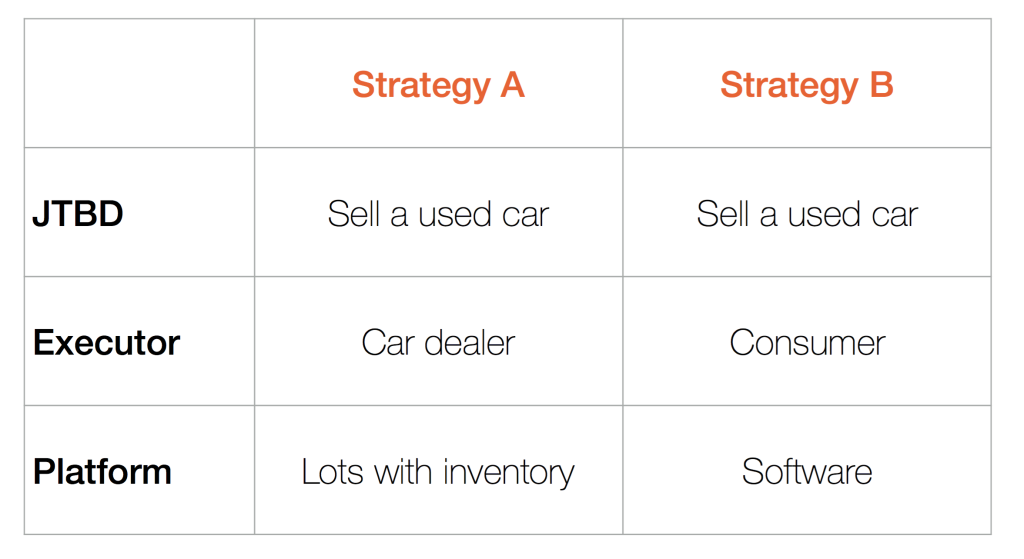
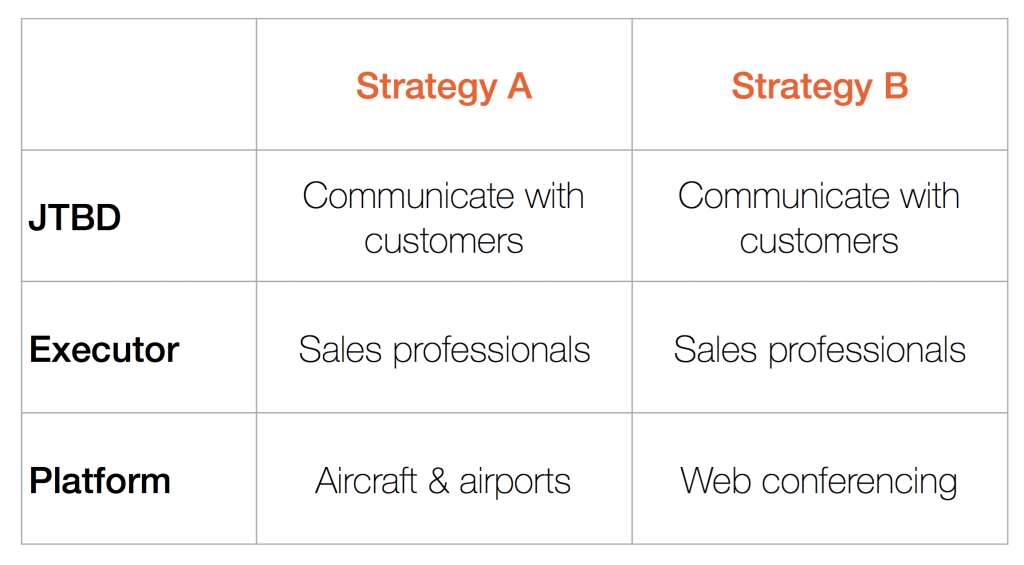
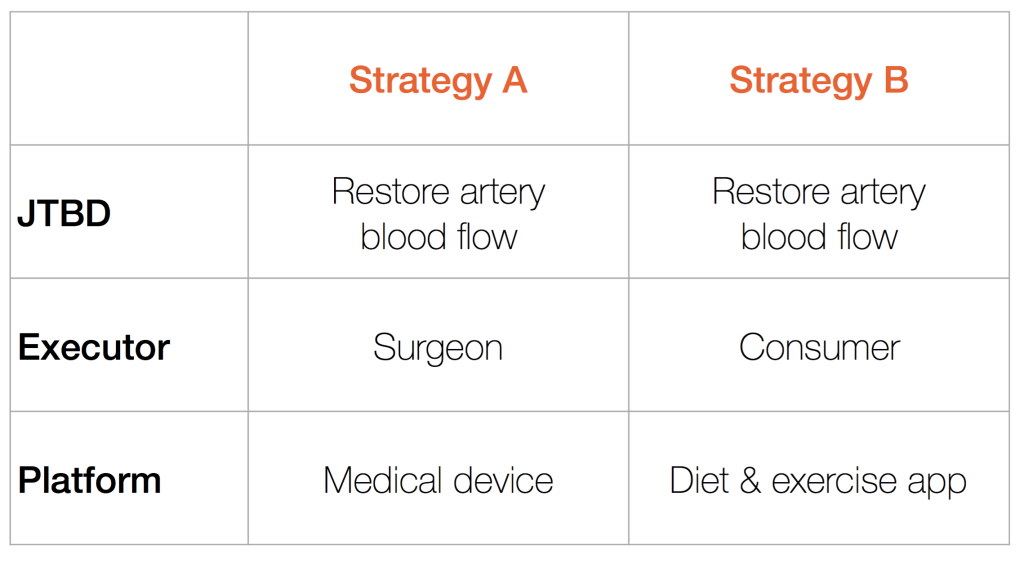
Now, let's look at Apple's strategy vs Samsung's strategy. Smartphones serve many, many jobs, but for the purpose of this example, let's zoom out and look at just three of them.
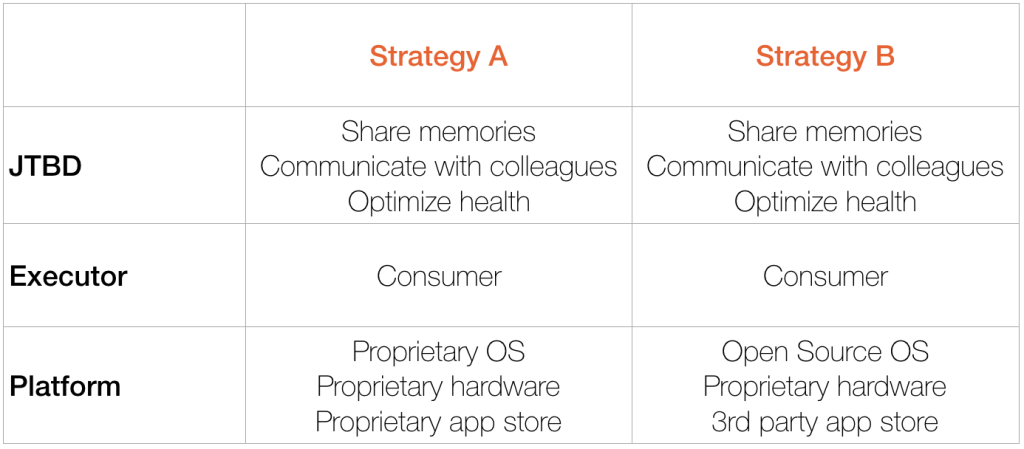
What do you notice?
The platform choice in Apple's product strategy has two major differences: a proprietary operating system (iOS) vs. an open source operating system (Android) and a proprietary app store vs a 3rd party app store.
Android has become a commodity. Any company can use Android to launch a mobile phone, which means it is very difficult to satisfy unmet needs in a job differently than the competition. In other words, it is very hard for Samsung to differentiate their Android phones from the competitors' Android phones.
On the other hand, iOS is proprietary, unique, and specifically designed to work with Apple's hardware and services. No other mobile phone company can use iOS, which makes it inherently differentiated, and there is a segment of customers willing to pay a premium for the satisfaction iOS delivers to them relative to Android.
Samsung's commodity OS forces them to attempt to differentiate mostly on hardware. By enhancing the hardware alone Samsung cannot add as much value to the needs in the job as Apple can by improving their hardware and software together. Samsung's investment in Tizen, an "operating system built from the ground up to address the needs of all stakeholders of the mobile and connected device ecosystem" is evidence that they too believe their platform choice is holding them back - not from market share, but from profit share.
By looking at Apple's Product Strategy choices through the lens of Jobs-to-be-Done, you see how they set themselves apart beyond simply choosing a different set of "activities."
The JTBD definition of product strategy can keep product teams focused on delivering results for the customer. It's clear, it's specific and it's easy to put on the wall and rally your team around it.
The Jobs-to-be-Done method helps you choose the strategy that will deliver higher profit share than your competitors. Here's what you do:
- Define your customer's job-to-be-done
- Identify the Customer Needs in the job-to-be-done
- Quantify the importance and satisfaction of the Customer Needs
- Segment the job executors based on unmet needs
- Analyze how well the competition satisfies the customer needs
- Make choices about product strategy using the following criteria:
Choose the job-to-be-done that has the most under-served needs for your customer.
Choose the job executor who will generate the highest value market based on their willingness to pay to get the job done and the number of job executors.
Choose the platform that can satisfy the unmet needs for your chosen job executor with the lowest amount of risk. The cost and risk of getting the job done for this job executor are critical. If it's too expensive and too risky, it'll eat into your profit.
These are the three choices that will lead you to a differentiated product strategy that can beat your competition. Of course, you'll also need superb execution, but that's another topic for another day.
Why not take a moment to ask your team what your product strategy is? Is your team using a definition based on operational activities or do you have a product strategy based on your customer's job-to-be-done? If you find they aren't aligned on what strategy to choose or even what a strategy is, get in touch with us here at thrv. We can help.








